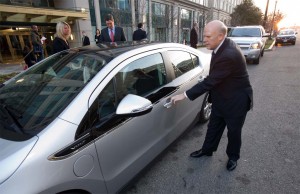General Motors CEO Dan Akerson faced a trial by fire today – quite literally – when he was grilled about a series of fires that occurred following federal crash tests of the maker’s Chevrolet Volt plug-in hybrid.
Akerson, by his own request, was one of those testifying during a hearing by a subcommittee of the House Oversight Committee with the provocative title, “What did NHTSA know and when did it know it.” The reference to Watergate and former Pres. Richard Nixon reflected the clear contention of committee leaders that the National Highway Traffic Safety Agency deliberately delayed issuing a public report on the first Volt fire for at least three months.
Some critics have suggested the agency was motivated by a desire to protect the Treasury’s stake in GM, which it first acquired as part of the bailout the maker received after going bankrupt in 2009. But Akerson denied that, and in prepared comments told the Oversight panel, “The Volt is safe. It’s a marvelous machine.”
That position was echoed during the Wednesday hearing by NHTSA Administrator David Strickland. His agency, which oversees automotive safety, briefly opened a formal investigation in December that could have led to a recall of the Chevrolet Volt, but the matter was closed, this month, after GM announced plans to modify the plug-in hybrid to enhance the safety of the battery pack.
The controversy officially centers around the timing of NHTSA’s handling of the Volt investigation. The first fire occurred weeks after a NHTSA-run side-impact crash test last spring, but the news wasn’t made public until November – and only then when the story appeared on several news wires. A second battery pack also caught fire days after it was tested in November, leading NHTSA to open a formal investigation – and prompting GM to develop the modifications it unveiled on January 5.
“Why didn’t you tell us (after the original fire)?” asked the chair of the House subcommittee, Ohio Republican Jim Jordan.
“This is about safety. This is about the government’s role,” added Darryl Issa, the California Republican who chairs the full Oversight Committee.
For his part, Strickland said the delay reflected uncertainty about what might have happened, especially as the first fire did not occur until weeks after the Volt crash test was conducted. It now appears that the test caused about a cupful of battery coolant to leak. And when the Volt was subsequently rotated – part of what is known as a “rotisserie test,” the liquid reached a circuit board atop the battery. Over time, the chemistry of the normally non-conductive coolant changed and caused a short circuit, triggering the fire.
Among other things, the modifications GM announced this month are meant to prevent such a problem.
Strickland, who faced some of the sharpest wrath of the committee members, stressed that it would have been counter-productive, perhaps even illegal, to disclose information about the original fire without first understanding what happened.
While the Wednesday hearings might have been pitched as focusing on automotive safety, politics clearly came into play, as underscored by the title the Republican-led committee adopted for the hearings.
General Motors has taken repeated punches from conservatives who questioned the need for the 2009 bailout. And Issa directly questioned whether the administration was willing to set aside safety concerns to cover for GM – which the U.S. Treasury still holds a one-third stake in.
During his time in the witness seat, CEO Akerson was asked by Cong. Issa if NHTSA’s actions following the fire were “more aggressive or less aggressive” than what might normally happen in the event a vehicle safety defect were discovered. The GM chief executive responded that he thought the agency’s actions were “proportional” to the problem.
Akerson stressed that GM was not contacted by the White House in regards to the fire. He also dismissed a refrain expressed by many Republicans that it was the administration that pressed GM to develop an electric vehicle that the maker itself didn’t want to build. In fact, it now appears the maker had to convince the White House to allow work on the Chevy Volt to continue following GM’s emergence from bankruptcy in July 2009.
He pointed out that the vehicle was publicly unveiled in October 2008, before the presidential election won by Barack Obama. “GM’s decision was not based on any clairvoyant power to correctly predict the 2008 presidential election,” Akerson’s prepared remarks noted.
During his time on the stand, Akerson added that, “I will testify in front of the good lord that this administration has never had a presence in the boardroom or any input in the operation of the business.”
The executive did express frustration at the way the debate over Volt has been politicized, suggesting the headlines have caused “collateral damage” that could hurt sales.
Momentum had been building for the Chevrolet Volt during the final months of 2011. And though the plug-in hybrid fell short of its sales goals for the year, GM had entered 2012 hoping to boost production levels to as much as 60,000 units, three-fourths of those for the U.S. market. Now, warned Akerson, once-positive consumer sentiment could be waning and, “We’re going to have to work hard to get it back.”
Nonetheless, Cong. Issa remained convinced that NHTSA had erred, declaring, “We are disappointed” in what he labeled a “statutory cover-up.”

